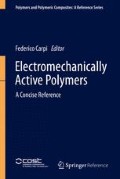Abstract
The effective use of dielectric elastomers (DE) in actual transducers requires the definition of reliable design tools which correctly predict their electromechanical behavior. In this chapter, we present two different approaches for modeling DE. The first approach is focussed on describing the electroelastic behavior of DEs in the framework of finite-strain electromechanics. The second approach, based on lumped parameters, is motivated by the desire to provide a simple and adequate description of the behavior of DE actuators under the influence of an electrical voltage applied to the electrodes.
Access this chapter
Tax calculation will be finalised at checkout
Purchases are for personal use only
References
Bagley RL (1989) Power law and fractional calculus model of viscoelasticity. AIAA J 27:1412–1417
Bertoldi K, Gei M (2011) Instabilities in multilayered soft dielectrics. J Mech Phys Solids 59:18–42
Carpi F, Gei M (2013) Predictive stress–stretch models of elastomers up to the characteristic flex. Smart Mater Struct 22(10):104011
Dorfmann A, Ogden RW (2005) Nonlinear electroelasticity. Acta Mech 174:167–183
Gent AN (1992) Engineering with rubber: how to design rubber components. Hanser Verlag, Munich
Haus H, Matysek M, Mößinger H et al (2013) Modelling and characterization of dielectric elastomer stack actuators. Smart Mater Struct 22:104009 (12pp)
Koeller RC (1984) Applications of fractional calculus to the theory of viscoelasticity. J Appl Mech 51:299–307
Lotz P (2009) Dielektrische Elastomerstapelaktoren für ein peristaltisches Fluidfördersystem. Dissertation Technische Universität Darmstadt, Darmstadt
Lotz P, Matysek M, Schlaak HF (2011) Fabrication and application of miniaturized dielectric elastomer stack actuators. IEEE/ASME Trans Mechatron 16:58–66
Moré JJ (1978) The Levenberg-Marquardt algorithm: Implementation and theory, in numerical analysis, Bd. 630, G. A. Watson, Hrsg. Springer Berlin Heidelberg, S. 105–116
Matysek M (2010) Dielektrische Elastomeraktoren in Multilayer-Technologie für taktile Displays. Dissertation Technische Universität Darmstadt, Darmstadt
Matysek M, Lotz P, Flittner K et al (2008) High-precision characterization of dielectric elastomer stack actuators and their material parameters. Smart Struct Mater: Proc SPIE 6927:692722
McMeeking RM, Landis CM (2005) Electrostatic forces and stored energy for deformable dielectric materials. J Appl Mech 72:581–590
Mößinger H (2010) Demonstrating the application of dielectric polymer actuators for tactile feedback in a mobile consumer device. Master thesis technische Universität Darmstadt, Darmstadt
Ogden RW (1997) Nonlinear elastic deformations. Dover, New York
Pelrine RE, Kornbluh RD, Joseph JP (1998) Electrostriction of polymer dielectrics with compliant electrodes as a means of actuation. Sensors Actuators 64:77–85
Schlaak HF, Jungmann M, Matysek M et al (2005) Novel multilayer electrostatic solid state actuators with elastic dielectric. Smart Struct Mater: Proc. SPIE 5759:121–133
Schmidt A, Gaul L (2001) Bestimmung des komplexen Elastizitätsmoduls eines Polymers zur Identifikation eines viskoelastischen Stoffgesetzes mit fraktionalen Zeitableitungen. In: Proceedings of Deutsche Gesellschaft für Zerstörungsfreie Prüfung Jahrestagung 75, Berlin
Suo Z, Zhao X, Green WH (2008) A nonlinear field theory of deformable dielctrics. J Mech Phys Solids 56(2):467–486
van der Pauw LJ (1958) A method of measuring the resistivity and hall coefficient on lamellae of arbitrary shape. Philips Tech Rev 20:220–224
Author information
Authors and Affiliations
Corresponding author
Editor information
Editors and Affiliations
Rights and permissions
Copyright information
© 2016 Springer International Publishing Switzerland
About this entry
Cite this entry
Schlaak, H.F., Gei, M., Bortot, E., Haus, H., Mößinger, H. (2016). Dielectric Elastomers as EAPs: Models. In: Carpi, F. (eds) Electromechanically Active Polymers. Polymers and Polymeric Composites: A Reference Series. Springer, Cham. https://doi.org/10.1007/978-3-319-31530-0_32
Download citation
DOI: https://doi.org/10.1007/978-3-319-31530-0_32
Published:
Publisher Name: Springer, Cham
Print ISBN: 978-3-319-31528-7
Online ISBN: 978-3-319-31530-0
eBook Packages: Chemistry and Materials ScienceReference Module Physical and Materials ScienceReference Module Chemistry, Materials and Physics

